6/15/2017
cover
cover
next page >
title:
author:
publisher:
isbn10 | asin:
print isbn13:
ebook isbn13:
language:
subject
publication date:
lcc:
ddc:
subject:
An Introduction to Computational Learning Theory
Kearns, Michael J.; Vazirani, Umesh Virkumar.
MIT Press
9780262111935
9780585350530
English
Machine learning, Artificial intelligence, Algorithms,
Neural networks (Computer science)
1994
Q325.5.K44 1994eb
006.3
Machine learning, Artificial intelligence, Algorithms,
Neural networks (Computer science)
cover
next page >
If you like this book, buy it!
file:///Users/zouzhiyuan/Documents/ResearchFiles/Book/An%20Introduction%20to%20Computational%20Learning%20Theory/files/cover.html
1/1
�
6/15/2017
< previous page
page_iii
page_iii
next page >
Page iii
An Introduction to Computational Learning Theory
Michael J. Kearns
Umesh V. Vazirani
< previous page
page_iii
If you like this book, buy it!
next page >
file:///Users/zouzhiyuan/Documents/ResearchFiles/Book/An%20Introduction%20to%20Computational%20Learning%20Theory/files/page_iii.html
1/1
�
6/15/2017
< previous page
page_iv
page_iv
next page >
Page iv
Second printing, 1997
©1994 Massachusetts Institute of Technology
All rights reserved. No part of this book may be reproduced in any form by any electronic or mechanical
means (including photocopying, recording, or information storage and retrieval) without permission in
writing from the publisher.
This book was typeset by the authors and was printed and bound in the United States of America.
Library of Congress Cataloging-in-Publication Data
Kearns, Michael J.
An introduction to computational learning theory / Michael J.
Kearns, Umesh V. Vazirani.
p. cm.
Includes bibliographical references and index.
ISBN 0-262-11193-4
1. Machine learning. 2. Artificial intelligence. 3. Algorithms.
4. Neural networks. I. Vazirani, Umesh Virkumar. II. Title.
Q325.5.K44 1994
006.3dc20 94-16588
CIP
< previous page
page_iv
If you like this book, buy it!
next page >
file:///Users/zouzhiyuan/Documents/ResearchFiles/Book/An%20Introduction%20to%20Computational%20Learning%20Theory/files/page_iv.html
1/1
�
6/15/2017
< previous page
page_v
page_v
next page >
Page v
Contents
Preface
1
The Probably Approximately Correct Learning Model
1.1 A Rectangle Learning Game
1.2 A General Model
1.2.1 Definition of the PAC Model
1.2.2 Representation Size and Instance Dimension
1.3 Learning Boolean Conjunctions
1.4 Intractability of Learning 3-Term DNF Formulae
1.5 Using 3-CNF Formulae to Avoid Intractability
1.6 Exercises
1.7 Bibliographic Notes
2
Occam's Razor
2.1 Occam Learning and Succinctness
xi
1
1
6
7
12
16
18
22
26
28
31
33
< previous page
page_v
If you like this book, buy it!
next page >
file:///Users/zouzhiyuan/Documents/ResearchFiles/Book/An%20Introduction%20to%20Computational%20Learning%20Theory/files/page_v.html
1/1
�
6/15/2017
< previous page
page_vi
page_vi
next page >
Page vi
2.2 Improving the Sample Size for Learning Conjunctions
2.3 Learning Conjunctions with Few Relevant Variables
2.4 Learning Decision Lists
2.5 Exercises
2.6 Bibliographic Notes
3
The Vapnik-Chervonenkis Dimension
3.1 When Can Infinite Classes Be Learned with a Finite Sample?
3.2 The Vapnik-Chervonenkis Dimension
3.3 Examples of the VC Dimension
3.4 A Polynomial Bound on |PC(S)|
3.5 A Polynomial Bound on the Sample Size for PAC Learning
3.5.1 The Importance of e-Nets
3.5.2 A Small e-Net from Random Sampling
3.6 Sample Size Lower Bounds
3.7 An Application to Neural Networks
3.8 Exercises
3.9 Bibliographic Notes
4
Weak and Strong Learning
4.1 A Relaxed Definition of Learning?
4.2 Boosting the Confidence
37
38
42
44
46
49
49
50
51
54
57
57
59
62
64
67
70
73
73
76
< previous page
page_vi
If you like this book, buy it!
next page >
file:///Users/zouzhiyuan/Documents/ResearchFiles/Book/An%20Introduction%20to%20Computational%20Learning%20Theory/files/page_vi.html
1/1
�
6/15/2017
< previous page
page_vii
page_vii
next page >
Page vii
4.3 Boosting the Accuracy
4.3.1 A Modest Accuracy Boosting Procedure
4.3.2 Error Analysis for the Modest Procedure
4.3.3 A Recursive Accuracy Boosting Algorithm
4.3.4 Bounding the Depth of the Recursion
4.3.5 Analysis of Filtering Efficiency
4.3.6 Finishing Up
4.4 Exercises
4.5 Bibliographic Notes
5
Learning in the Presence of Noise
5.1 The Classification Noise Model
5.2 An Algorithm for Learning Conjunctions from Statistics
5.3 The Statistical Query Learning Model
5.4 Simulating Statistical Queries in the Presence of Noise
5.4.1 A Nice Decomposition of Pc
5.4.2 Solving for an Estimate of Pc
5.4.3 Guessing and Verifying the Noise Rate
5.4.4 Description of the Simulation Algorithm
5.5 Exercises
5.6 Bibliographic Notes
< previous page
78
79
81
85
88
89
96
101
102
103
104
106
108
111
112
114
115
117
119
121
page_vii
If you like this book, buy it!
next page >
file:///Users/zouzhiyuan/Documents/ResearchFiles/Book/An%20Introduction%20to%20Computational%20Learning%20Theory/files/page_vii.html
1/1
�
6/15/2017
< previous page
page_viii
page_viii
next page >
Page viii
6
Inherent Unpredictability
6.1 Representation Dependent and Independent Hardness
6.2 The Discrete Cube Root Problem
6.2.1 The Difficulty of Discrete Cube Roots
6.2.2 Discrete Cube Roots As a Learning Problem
6.3 Small Boolean Circuits Are Inherently Unpredictable
6.4 Reducing the Depth of Inherently Unpredictable Circuits
6.4.1 Expanding the Input
6.5 A General Method and Its Application to Neural Networks
6.6 Exercises
6.7 Bibliographic Notes
7
Reducibility in PAC Learning
7.1 Reducing DNF to Monotone DNF
7.2 A General Method for Reducibility
7.3 Reducing Boolean Formulae to Finite Automata
7.4 Exercises
7.5 Bibliographic Notes
8
Learning Finite Automata by Experimentation
8.1 Active and Passive Learning
8.2 Exact Learning Using Queries
123
123
124
126
128
131
133
135
139
140
141
143
144
147
149
153
154
155
155
158
< previous page
page_viii
If you like this book, buy it!
next page >
file:///Users/zouzhiyuan/Documents/ResearchFiles/Book/An%20Introduction%20to%20Computational%20Learning%20Theory/files/page_viii.html
1/1
�
6/15/2017
< previous page
page_ix
page_ix
next page >
Page ix
8.3 Exact Learning of Finite Automata
8.3.1 Access Strings and Distinguishing Strings
8.3.2 An Efficiently Computable State Partition
8.3.3 The Tentative Hypothesis
8.3.4 Using a Counterexample
8.3.5 The Algorithm for Learning Finite Automata
8.3.6 Running Time Analysis
8.4 Learning without a Reset
8.4.1 Using a Homing Sequence to Learn
8.4.2 Building a Homing Sequence Using Oversized Generalized
Classification Trees
8.4.3 The No-Reset Algorithm
8.4.4 Making Sure Ls Builds Generalized Classification Trees
8.5 Exercises
8.6 Bibliographic Notes
9
Appendix: Some Tools for Probabilistic Analysis
9.1 The Union Bound
9.2 Markov's Inequality
9.3 Chernoff Bounds
< previous page
160
160
162
164
166
169
171
174
176
178
181
182
185
186
189
189
189
190
page_ix
If you like this book, buy it!
next page >
file:///Users/zouzhiyuan/Documents/ResearchFiles/Book/An%20Introduction%20to%20Computational%20Learning%20Theory/files/page_ix.html
1/1
�
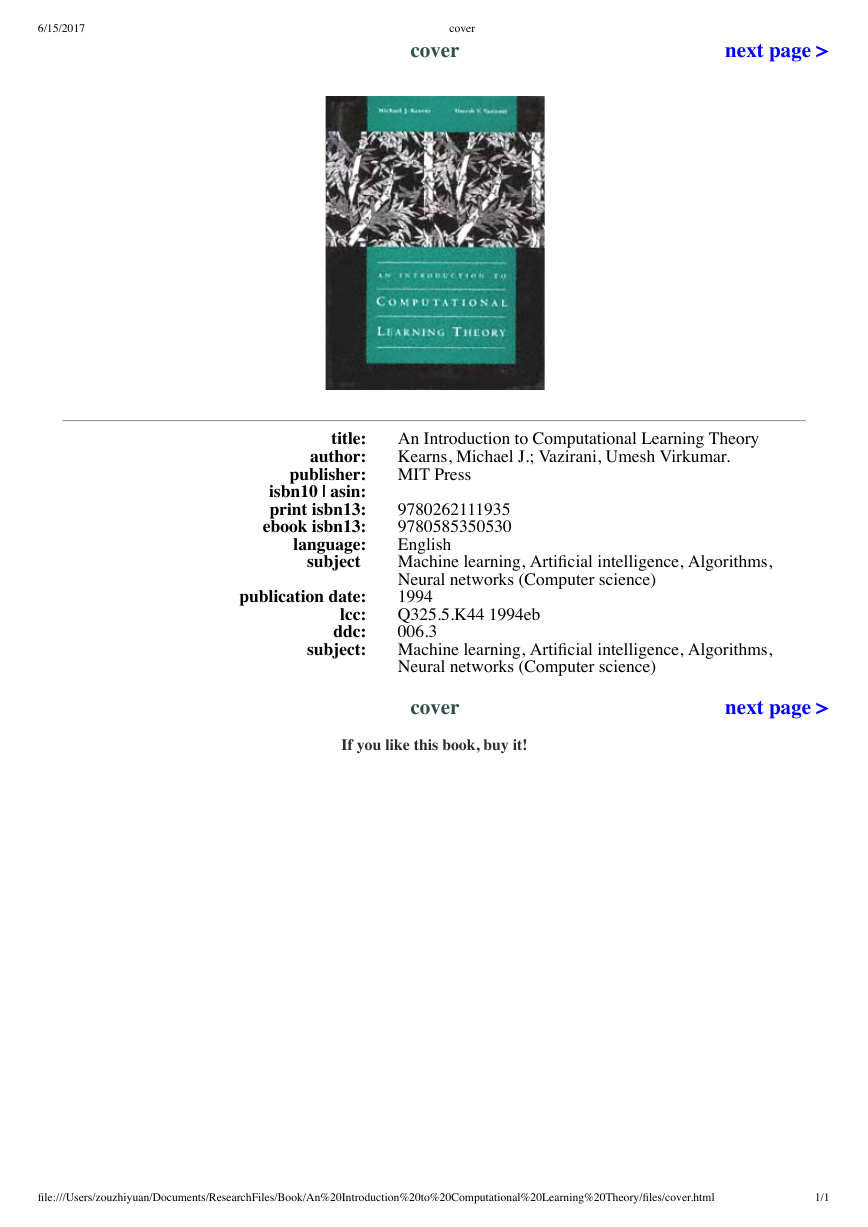
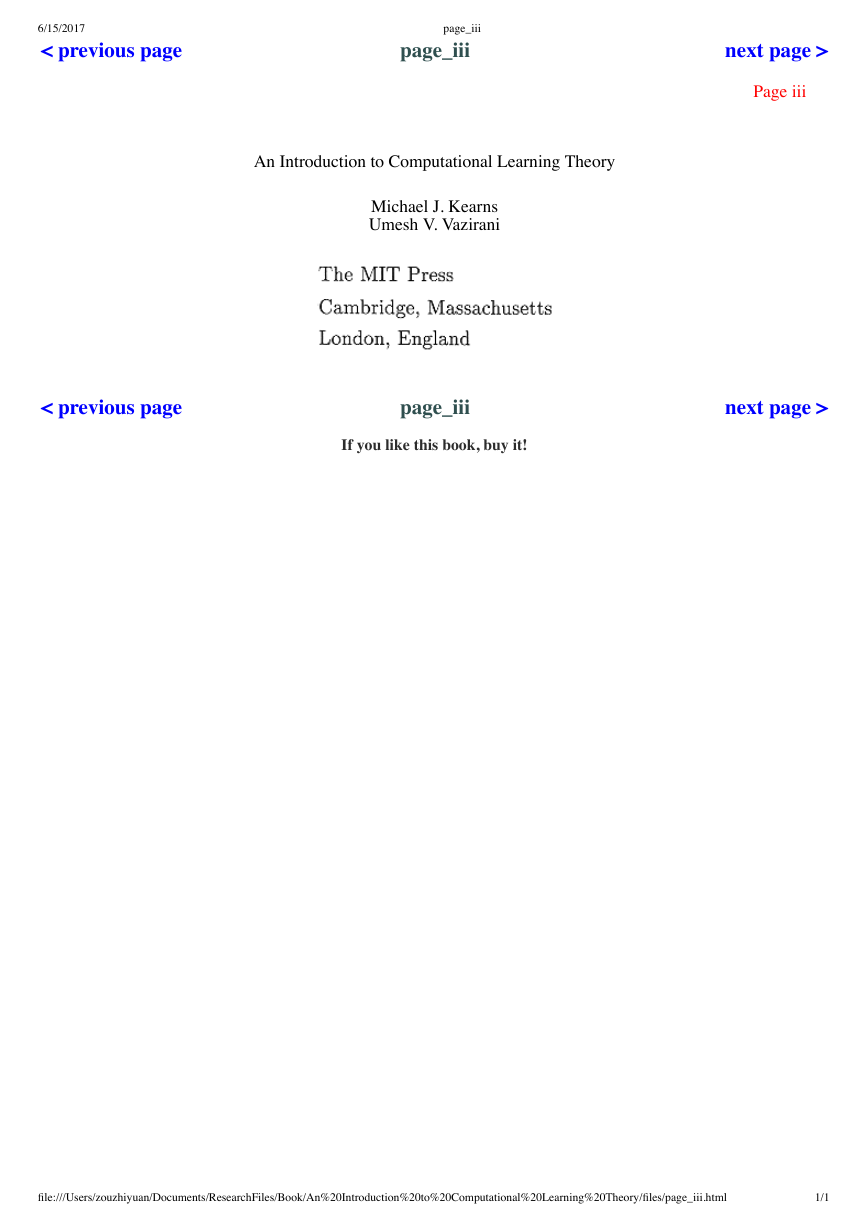

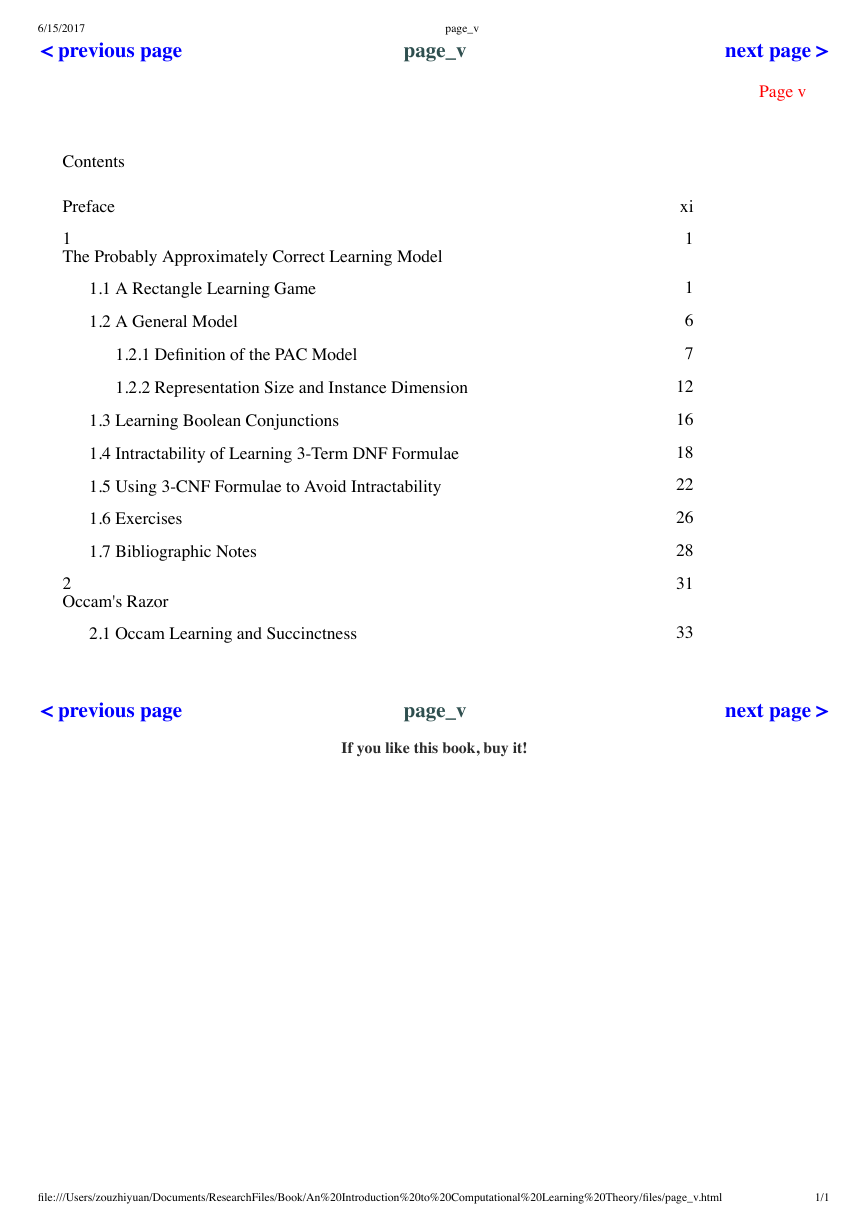
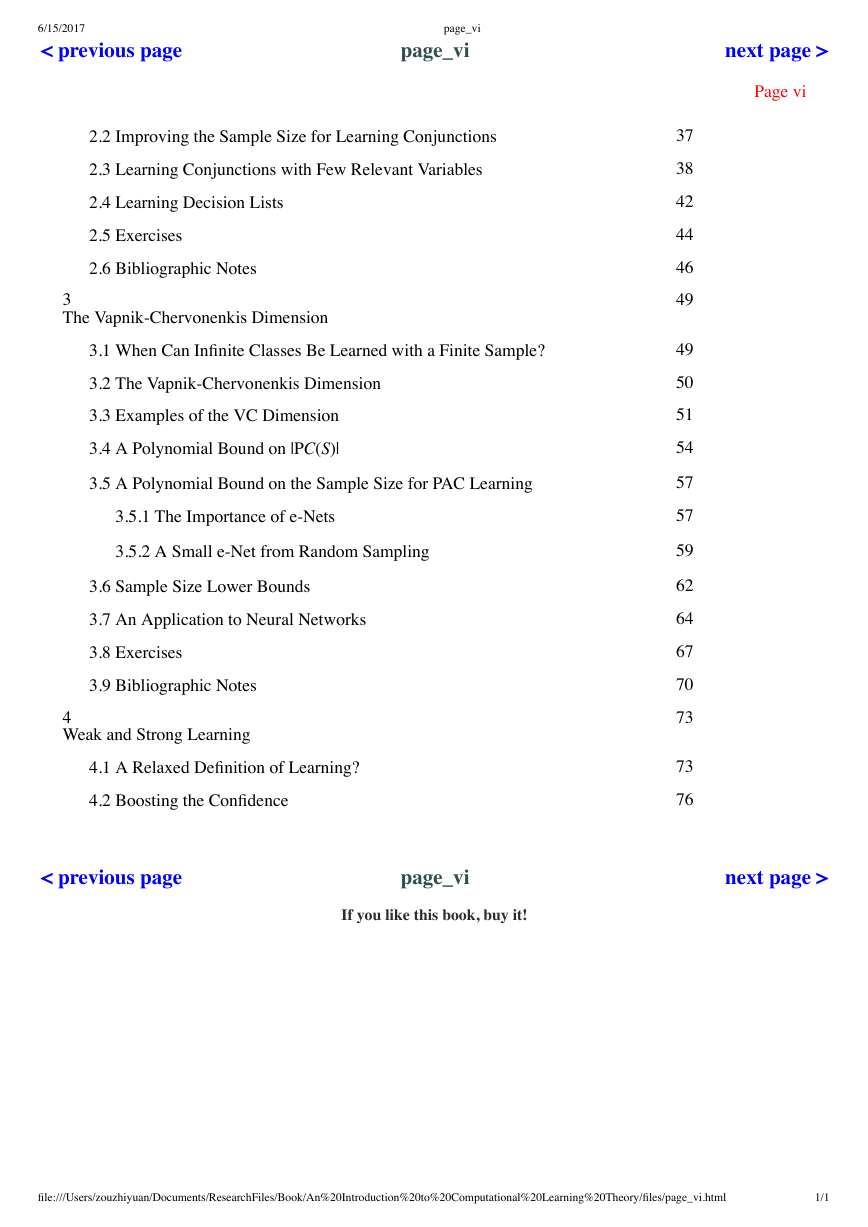
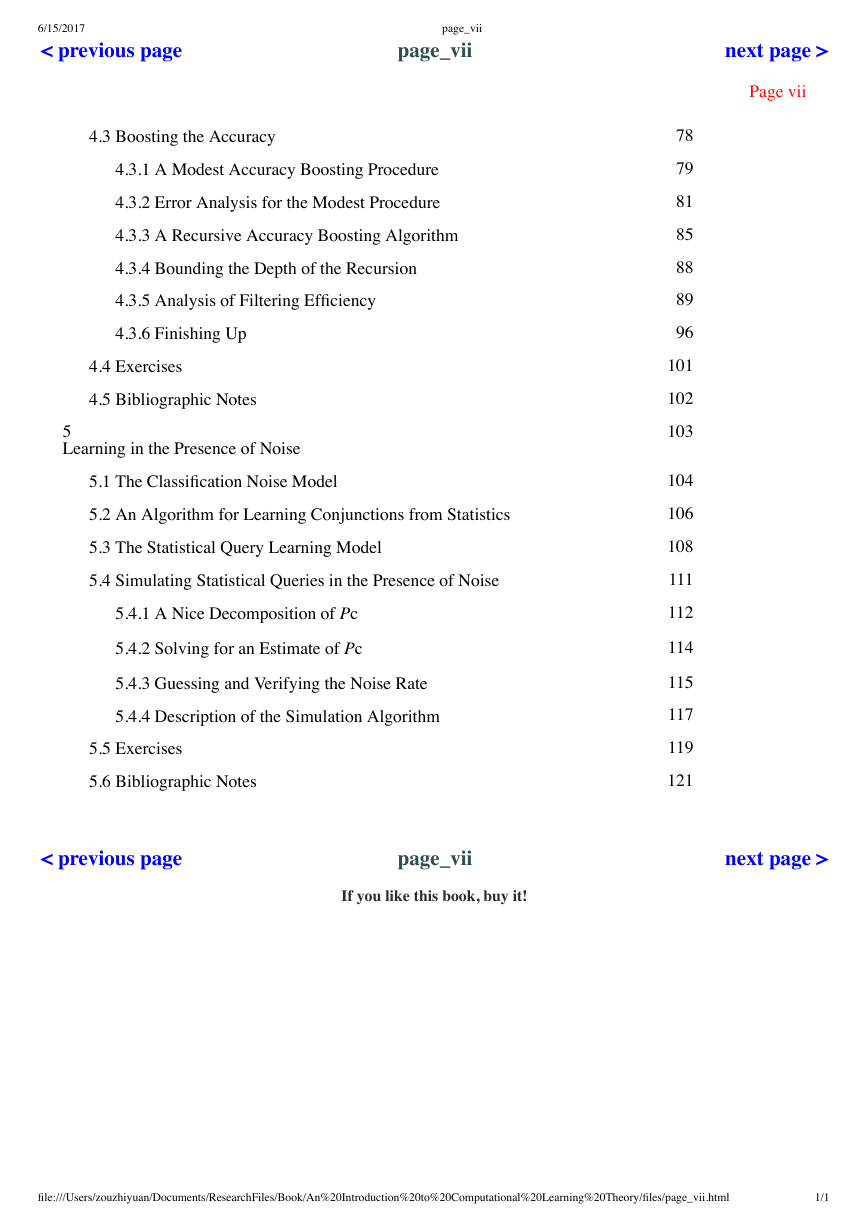










 2023年江西萍乡中考道德与法治真题及答案.doc
2023年江西萍乡中考道德与法治真题及答案.doc 2012年重庆南川中考生物真题及答案.doc
2012年重庆南川中考生物真题及答案.doc 2013年江西师范大学地理学综合及文艺理论基础考研真题.doc
2013年江西师范大学地理学综合及文艺理论基础考研真题.doc 2020年四川甘孜小升初语文真题及答案I卷.doc
2020年四川甘孜小升初语文真题及答案I卷.doc 2020年注册岩土工程师专业基础考试真题及答案.doc
2020年注册岩土工程师专业基础考试真题及答案.doc 2023-2024学年福建省厦门市九年级上学期数学月考试题及答案.doc
2023-2024学年福建省厦门市九年级上学期数学月考试题及答案.doc 2021-2022学年辽宁省沈阳市大东区九年级上学期语文期末试题及答案.doc
2021-2022学年辽宁省沈阳市大东区九年级上学期语文期末试题及答案.doc 2022-2023学年北京东城区初三第一学期物理期末试卷及答案.doc
2022-2023学年北京东城区初三第一学期物理期末试卷及答案.doc 2018上半年江西教师资格初中地理学科知识与教学能力真题及答案.doc
2018上半年江西教师资格初中地理学科知识与教学能力真题及答案.doc 2012年河北国家公务员申论考试真题及答案-省级.doc
2012年河北国家公务员申论考试真题及答案-省级.doc 2020-2021学年江苏省扬州市江都区邵樊片九年级上学期数学第一次质量检测试题及答案.doc
2020-2021学年江苏省扬州市江都区邵樊片九年级上学期数学第一次质量检测试题及答案.doc 2022下半年黑龙江教师资格证中学综合素质真题及答案.doc
2022下半年黑龙江教师资格证中学综合素质真题及答案.doc